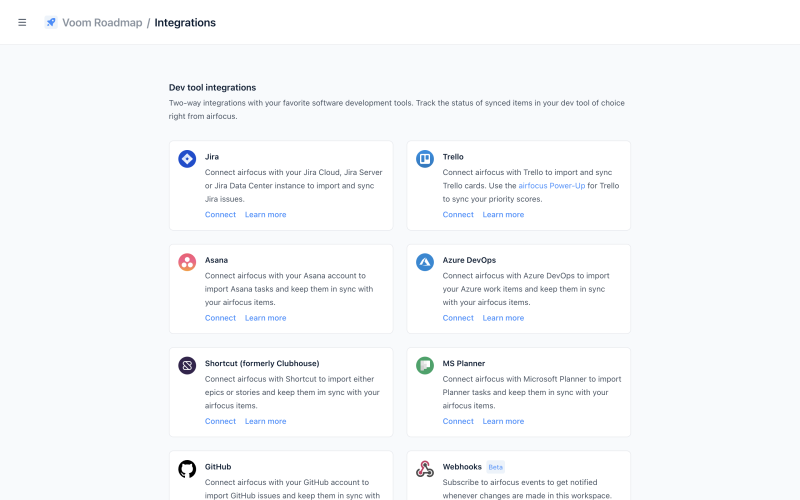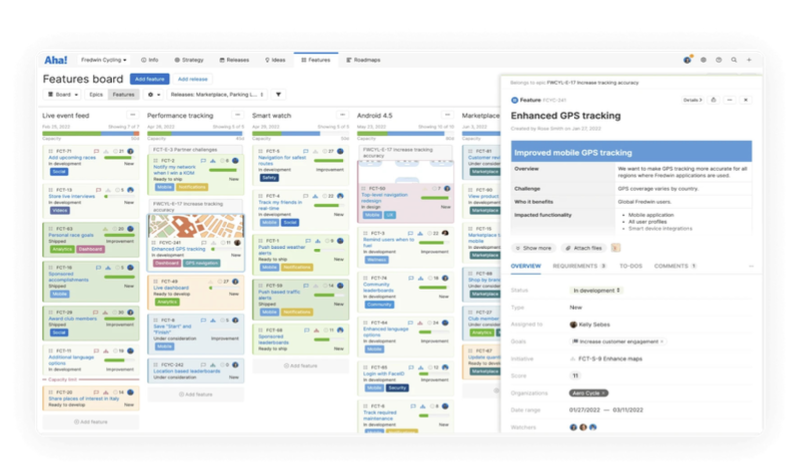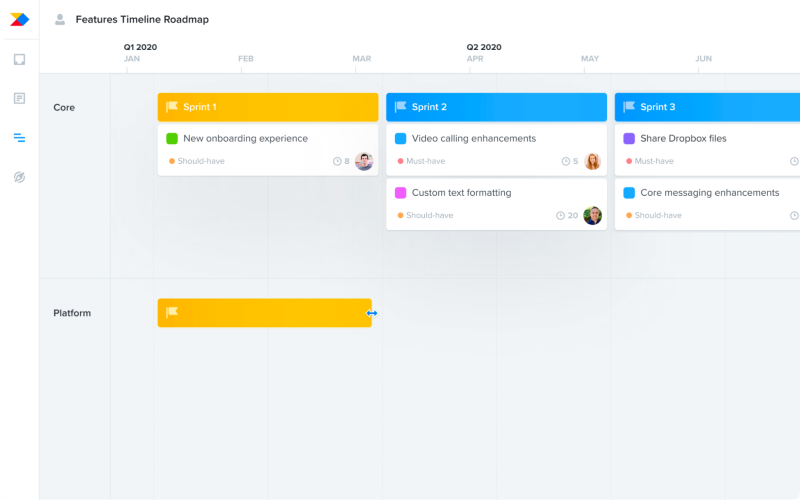How to Evaluate and Select B2B SaaS Tools for Product Management

Product teams work with skilled stakeholders to solve customer and business problems with technology. They accomplish this by understanding market needs, launching solutions, and numerous iterations post-release.
Products are often categorized based on the industry they serve, however, another categorization is based on who they are meant to serve, customers or businesses.
Products that are focused on servicing customers are known as business-to-consumer (B2C) products, and those focused on serving businesses are known as business-to-business (B2B) products.
We will refer to them by their acronyms for the remainder of this article.

B2C vs. B2B products
B2B products are offered directly to end users to solve their problems.
For example, anyone who wants to consume music can download Spotify and pay for a monthly subscription.
B2B products are digital solutions that solve business problems.
Salesforce, for example, is not purchased and used by the everyday consumer. Business executives rely on it for their business needs.
Product teams need reliable tools to support their product management process. However, there are some differences between how product management is practiced for B2C and B2B products that need to be considered during software evaluation.
Product management for B2C and B2B products
Here are some of the key differences between how product management is practiced with B2C and B2B products.
Target customer
With B2C products the focus is on serving individual customers.
Product teams understand consumer wants, needs, identify their behaviors, and gather their feedback to ensure that their needs are met.
With B2B products, to deliver value product teams must understand the business’s unique needs, its industry, and the needs of the various stakeholders within the.
Sales cycle
With B2C products the sales cycle is short and non-complex.
B2B products have longer and more complex sales cycles.
This is due to the multiple stakeholders who need to be consulted, decision makers, influencers, and champions within the business, along with the detailed analysis of whether the product meets the business's requirements.

Customization
B2C products are generally standard, built to meet the needs of the majority of their consumer base.
B2B products however often require a higher level of customization to meet business requirements.
There are often customization options for business stakeholders to modify the product according to their needs.
Product managers must work closely with these stakeholders to understand their needs, prioritize requests, and provide timelines.
Release flexibility
Product teams can release B2C product improvements and updates when they choose to do so. If they provide advance notice to their user base it is by choice.
B2B product teams however don’t have this leeway.
Customization and enhancement requests from business stakeholders are often requested to support the goals and strategic initiatives of the business. And sometimes they are needed to unblock other initiatives.
Business leaders must know when they will receive their requests as their business operations depend on them.
There are many more differences besides these four, relating to other factors including decision making, data and analytics, the product life cycle, capturing feedback, and more.
However, let’s outline some of the benefits that product teams can actualize when they take advantage of B2B product management tools.

Benefits of B2B product management tools
A B2B SaaS product management tool supports product teams with their product management processes and workflows.
They come with many capabilities which include:
Streamlined workflows
B2B product management tools enable product teams to streamline their daily tasks. With modular product management tools like airfocus, teams can customize their workflows to get work done faster, their way
Improved collaboration
Product leaders can better collaborate with other teams to make decisions, share information, and make decisions.
Enhanced productivity
With the multiple features and capabilities available, they reduce the manual effort that product teams perform. Ultimately helping them and key stakeholders increase their productivity and efficiency.
Key considerations for B2B software selection
Here are some of the key areas to consider when evaluating B2B product management tools.
Functionality
Understand the specific functionality that your team requires. It’s helpful to jot down a list of the problems that you want to solve along with the functionality to do so.
While it’s standard for product management tools to offer roadmapping capabilities, know the specific capabilities that you need.
Perhaps you need the ability to create customizable roadmaps to specific views and collaborate with business stakeholders while keeping them informed.
And what about feedback management? This comes in handy when you need to gather feedback from business leaders.
This process can be streamlined when customers have a specific channel where they can provide feedback themselves.
User interface
A nice design and seamless user experience makes it easier for users to adopt products.
This is also an important factor to consider if your customers will interact with this tool as well.
Consider the product’s user interface and analyze whether you can navigate through it alone. And if assistance is required, find out if an onboarding process is offered.
Integration capabilities
Software companies that service B2B businesses often have many other tools that they use to deliver value to their customers. These include project management tools, customer success tools, data analysis tools, and more.
Consider the integrations that are offered and if they match the ones that your team uses.
Integrations are a key differentiating factor. airfocus for example not only offers a list of integrations, but also detailed steps on how to set them up.

Product demos/Free trial
Are demos of the product available? And if so, what about a free trial for you to take the tool for a run?
Live demos are beneficial, but testing the tool will give you a much better understanding if it will meet your team’s needs.
Scalability
The more businesses you serve the more this tool will be pushed to its limits.
When you select a tool with scalability in mind then you can continue to rely on it in the long term. Rather than having to switch tools every couple of years because the initial tool selected does not support your growth.
This is just a short list, some other factors to consider include: security, customer support, customer reviews, and more.

4 B2B Product management tools to consider
While there are many B2B product management tools available, here are 4 that you should check out.
1. airfocus

Whether you support B2C or B2B products, airfocus is the only modular collaborative product management tool that will support your product management process.
Create roadmaps in a manner of minutes with out-of-the-box ready to use templates. Customize the templates and share specific views with stakeholders to keep them up to date on progress.
Teams can even roll up various roadmaps into one single source of truth, and seamlessly share and export roadmaps via secure URLs and exports.
Not only can product teams centralize feedback from various sources and stakeholders, with Insights, business leaders can directly share feedback themselves.
This visually appealing tool with a seamless product experience also offers multiple two-way integrations with notable development and feedback tools.
airfocus also recently added an embedded Objectives and OKRs app that helps you connect strategy with execution, get everyone aligned and understand how every goal contributes to the overall business objectives. Pros and Cons
Pros:
Robust integrations with development tools like Jira, Github, and Asana
Ability to create and share roadmaps
Consolidation of multiple roadmaps into a portfolio view
Customizable fields and views
Personalized prioritization system, including priority poker
Focus on customer feedback via their feedback portal and insights apps
Intuitive and fast setup process
Embedded Objectives and OKRs.
Cons:
Some time needed to grasp the modularity concept
2. Aha!

Aha! Is a roadmapping tool for product teams to create roadmaps and share product development plans with stakeholders.
Roadmaps can be customized to meet the needs of various audiences and shared via custom presentations or secure web pages.
With its ideas portal, product teams can crowdsource feedback from customers, engage with their community, and analyze trends.
Pros and Cons
Pros:
Enhanced backlog management
Adaptable and flexible fields
Comprehensive tracking and reporting
Customer engagement and feedback gathering
Cons:
Confined to Gantt chart-style roadmapping
Includes numerous features that might be superfluous for some users
Feature management depends on voting rather than a problem-solving strategy
Challenging learning curve
3. Productboard

Productboard is an end-to-end product management platform built for product teams to gather insights, prioritize work, and align stakeholders with roadmaps.
Product teams can centralize customer feedback, validate ideas, and gain support for their end-to-end processes with multiple integrations.
It has high security standards, it also offers API support.
Pros and cons
Pros:
Prioritizes customer feedback and insights
Provides a public portal for customer engagement
Offers the ability to share roadmaps
Cons
Unclear messaging about its approach to roadmaps and product management, lacking a clear distinction between project and product-based approaches
No focus on discovery, experimentation, or outcomes in the tool's functionality
High pricing
4. monday.com

With monday.com users can create the tools needed to get their work done with an interface that supports building blocks and integrations for teams to customize their work.
With this open platform product teams can maximize efficiencies and work at scale to adapt to the needs of large businesses.
Numerous product teams can rely on monday.com for roadmapping, managing their feature backlog, bug tracking, team communication, and more.
Pros and cons
Pros:
Adaptable and visually pleasing
Simple management
Ideal for project management, sales, and operations teams
Cons:
Lacks a dedicated emphasis on product management
Integrations and automation not included in the Basic pricing plan
Conclusion
Product teams need tools to support their product development process. However, not all tools are created equal.
Teams that manage B2B products must be aware of their specific needs and keep this in mind during their software selection process.
Rather than a tool that forces you to work a specific way, consider a modular tool that fits with your team's product development process.
Book a demo or start your free trial to learn more about how airfocus can assist your product management process.

Quadri Oshibotu

Read also






Experience the new way of doing product management

Experience the new way of doing product management



